part 15, and last chapter, of The Route Not Taken
This is the last of my series on the route planned for the Delaware Flemington Railroad Company, a rail line that was never built. In the survey, the train is finally approaching the station. But to get there it must traverse the properties of John C. Hopewell and William Hill, two prominent gentlemen who probably were not supporters of the railroad company.
Recall that this train was to begin at Prallsville and make its way northeast through Delaware Township toward Sergeantsville, passing to the southeast of the village and then northeast to Sand Brook. From there it was to cross into Raritan Township, passing near the Township Poor Farm, and the Hoagland and Sergeant farms, then across Dayton Road on its way to the depot in Flemington where many farmers would be waiting to load their produce.
I have had some difficulty finishing this series. So much interesting information turns up in my research that what seemed fairly simple, gets more and more complex. For instance, while researching the two landowners, Hopewell and Hill, I found myself discovering much about the development of the Village of Flemington, including the copper mining craze and the storekeeping scene. I finally realized that if I am to get this train to the station, I will have to save this history for another article, one more focused on the Village and its early residents and landowners.
The Final Landowners
As mentioned in previous articles, the railroad company’s engineer, Samuel C. Slaymaker, made a survey of the route and also a separate list of landowners, not all of whom appeared on the survey map. The landowners for the last leg of the trip were Thomas Edmonds & wife Joanna Fitzgerald, John C. Hopewell & wife Ann Housel, William Hill & wife Mary Burr and the Samuel Hill estate, and John N. Voorhees & wife Ellen Large. (Slaymaker, of course, did not name the wives, but since they also owned the properties, they get named here.) Two of those landowners, Hopewell & Hill, were impossible to miss on the Beers Atlas, and two could not be found in the path of the train. Of the latter, I will describe the Edmondsons, but will leave John N. Voorhees out. He was one those men who bought and sold many many properties, and it would take too much time to identify the one in the path of the railroad.
Thomas & Johanna Edmondson
Thomas Edmonds was actually Thomas Edmondson, an Irish immigrant farmer (b.1825) who left very little record of himself. He arrived from Liverpool in 1856 and soon afterwards married Joanna Fitzgerald. They had a daughter Mary Ann who died in 1862 when she was only four. The Edmondsons had three more children, but none survived to adulthood.
Edmondson may have come to America with some savings, because in December 1856 he was able to purchase, without a mortgage, a 7.57-acre lot from Samuel and Martha P. Johnson of Flemington for $600. It bordered land of William Hill, Charles Bartles, the Flemington Copper Co., and William B. Shrope. Ten years later, he bought another 7+ acre lot adjacent to the first from John G. and Sarah Reading for $1,506.1 The first lot had gone through the hands of the Flemington Copper Company, which sold it to Charles Bartles, who sold it to Jacob S. Smith & John L. VanFleet; Smith sold his share to VanFleet who then sold the 7.57-acre lot to Samuel Johnson for $474.30 on January 14, 1856.2 John Grandin Reading, owner of the second lot, had so much property in Flemington that it is hard to sort out where it all came from. Like Mr. Voorhees, I will have to save Mr. Reading for another time.
Edmondson bought some other properties in the early 1900s, but these two lots were the ones closest to the path of the proposed rail line. Edmondson farmed this small plot for the rest of his life. Given that he was not harvesting large acreage, it would be interesting to know what he was growing. (He was not included in Isaac S. Cramer’s survey of farmers.)
Joanna Edmondson died on June 12, 1911, age 79. Her husband followed on April 30, 1912, age 86. The couple were buried with their daughter Mary in the Prospect Hill Cemetery up above the town. A handsome memorial stone was set up by their heirs to help remember them.
The Beers, Comstock Atlas of 1873 is an indispensable help to anyone researching the history of Hunterdon County and Raritan Township in the 19th century. But when the mapmakers got to Flemington, they really outdid themselves. The map of the Village is beautiful! and very helpful for this article, despite the fact that I was unable to locate the Edmondson lot. However, the properties belonging to John C. Hopewell and William Hill are impossible to miss.
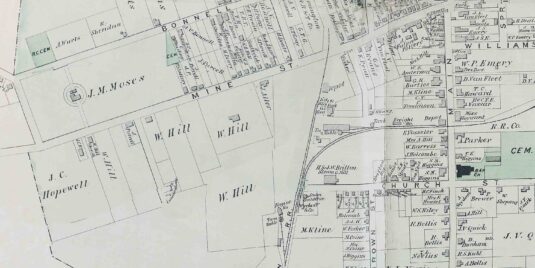
This detail shows that the Hopewell and Hill lots were located on Mine Street across from today’s Dvoor Farm and beautiful mansion once owned by Hugh Capner. But because the properties were quite large, there was room in the back for a train to run through on its way to the Depot on Main Street. (Today that area is taken up with developments.)
John C. Hopewell and Ann Housel
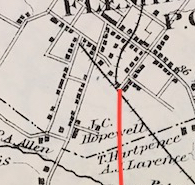 I am including here a detail from the Beers Map for Raritan Township because, unlike the Flemington map, this one shows “J. C. Hopewell” at the end of a long lane that runs off Mine Street. This was not where Hopewell actually lived; he owned several properties and lived on the one to the north of the Presbyterian Church on today’s East Main Street.
I am including here a detail from the Beers Map for Raritan Township because, unlike the Flemington map, this one shows “J. C. Hopewell” at the end of a long lane that runs off Mine Street. This was not where Hopewell actually lived; he owned several properties and lived on the one to the north of the Presbyterian Church on today’s East Main Street.
There is so much to say about this gentleman that I am obliged to reserve the tale of his life for another time. As both maps show, he was the owner of large acreage and several smaller lots in the Village when Beers made his Atlas in 1873. Hopewell had purchased those smaller village lot in the 1860s, but it was his purchase on February 15, 1870 that put him on Mine Street.
He bought three lots that day from the aforesaid John G. and Sarah Reading, who had just left Flemington for Philadelphia. He paid $13,000 for the lots, so we can safely assume they were already valuable. The first lot, of 21.86 acres, bordered land of William B. Shrope, the Mine Brook and William Hill, among others. In fact, one of the “others” was Thomas Edmondson, to whom Reading had already sold the lot of 7.25 acres. The 21.86 acres came to the Readings from Hopewell’s neighbors, William and Mary B. Hill, who sold it to Reading in 1860.3
The other two lots, of 32.06 and 10.97 acres were adjacent and bordering Mine Street. This additional property had also been sold to John G. Reading by William and Mary Hill in 1866 and had been sold to Hill by William & Mary Shrope in 1854.4
The census of 1870 shows that his many land investments and business interests had made John C. Hopewell significantly richer, with property valued at $115,000, and personal wealth at $60,000. John and Ann Hopewell were then each 54 years old. Living with them were their now adult children: Sarah age 35 unmarried, Joseph R. age 21, a grocer, and Charles F. age 17, clerk in a store.5 Also living with them was Ann Housel, age 80 (born c.1790). She was Ann Hopewell’s mother and widow of Abraham Housel who had died back in 1819 at the age of 34. As far as I can tell, Ann Housel Hopewell was the only child of that marriage.
One more item about Mr. Hopewell before moving on. When the Belvidere Delaware Railroad Company and the Flemington Railroad & Transportation Co. held their joint annual meetings in July 1870, John C. Hopewell was named a director of the latter company. When organizing began for a second railroad to run nearly parallel with the Flemington RR line, John C. Hopewell did not sign up.
I must now reluctantly leave the story of John C. Hopewell to look at his neighbor, William Hill and Hill’s father Samuel.
Two Samuel Hills
The 1850 map of Raritan Township shows “Samuel Hill” on today’s Mine St. across from the Flemington Mining Co., which was located on the old Hugh Capner property. “John Case” is shown on the other side of the creek. His lot is today known as the Dvoor Farm. The Beers Atlas indicates that by 1873, William Hill, the son of Samuel Hill and Alette Van Neste, had come into possession of this property.
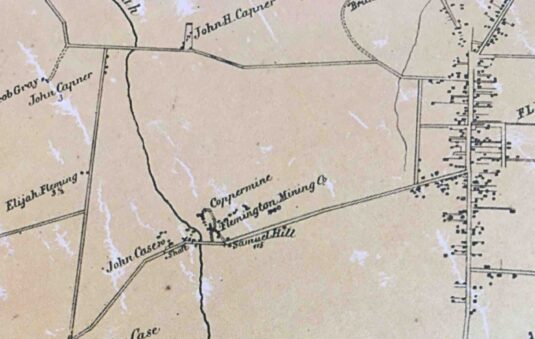
It was quite a challenge to sort out the men who shared the name Samuel Hill. I have previously written about the Samuel Hill who lived south of Flemington where he ran a tannery, and about 1768 married Martha Carman, sister of Elijah Carman (See “Carman, Hoagland & Higgins”). This Samuel was born about 1740 to Jonathan Hill and Sarah Smith and died in 1824. He wrote a will naming sons John & Asher Hill and friends Thomas Capner and William Bishop his executors. The Capner name made me think he might be the Samuel Hill of Mine Street, but that is not the case. (The Hill Family Tree for Samuel Hill of Copper Hill is an extensive one. The tree for Samuel Hill of Flemington is quite brief. I have appended it to the already published Jonathan Hill Tree.)
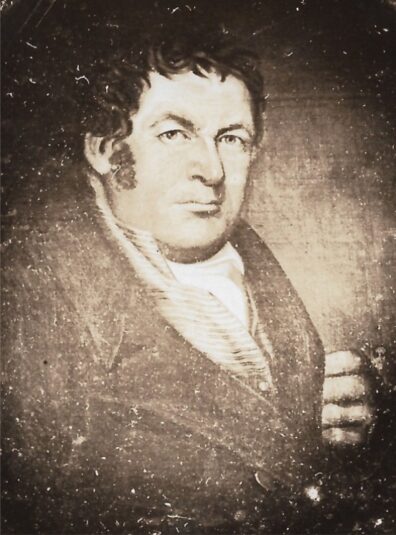
As far as I can tell, the two Samuel Hills were not related. The Samuel Hill who owned property along Mine Street was the founder of an “earthenworks” there, probably around 1815. He had been born in 1793 in New Brunswick, NJ to English immigrant Thomas Hill (left) and his first wife, Ann Capnerhurt (sister of Joseph & Thomas Capner). When the Capners moved to Flemington, the Hills’ son Samuel came with them.
Samuel Hill’s obituary stated that he had been a resident of Flemington for over 40 years. In fact, he made his first land purchase there on July 12, 1814, when he purchased the lot of 2.27 acres in Flemington for $1100 from William & Sarah Maxwell and John & Ann Maxwell, heirs of William Maxwell, Sr. In 1814, that description meant the intersection of Mine Street with Main Street, which is where Samuel Hill established his “earthenworks.” Oddly enough, on March 27, 1820, Samuel & Aletta Hill sold that lot to Samuel’s father Thomas Hill of New Brunswick for $2600.6 When Thomas Hill wrote his will on March 26, 1825, he bequeathed that lot to back to son Samuel, and included a lengthy description, which is how we know that Samuel had gotten it from William Maxwell. As it happens, the Samuel Hill of Copper Hill had also bought land from William Maxwell, but not in Flemington.
Not long after buying the lot in Flemington from William & Sarah Maxwell, Samuel Hill married Aletta (or Alletta) Van Neste (1787-1875), daughter of Abraham Van Neste and Catharine Sebring of Somerset County, on June 18, 1817. They had three children, two of whom were twins: Catharine & Henrietta. Catharine (1826-1882) married William Evans Anderson, who acquired property in Flemington near the Hopewells. Henrietta remained unmarried. Son William gets discussed below.
Although Samuel Hill owned a lot of real estate, he seems to have made much of his wealth through his “earthenware factory,” which he established in Flemington about the time of his marriage. You can see its location on the Beers Flemington Map—it is labeled “A. Fulper Pottery,” because by 1873 the pottery had been taken over by Hill’s right-hand man, Abraham Fulper.
There is certainly much more to say about the pottery, but since it does not directly abut the path of the proposed railroad, I will save it for a future article.
Samuel Hill was very civic-minded. He served on the Township Committee of the newly formed Raritan Township in 1838 and as a Judge on the Court of Common Pleas for 20 years. He was a Whig in his politics, and when that party was replaced in 1854 with the new Republican Party, Hill joined up. The editor of the Hunterdon Republican newspaper wrote that the party’s first meeting in Hunterdon County was attended mostly by ‘ex-Whigs.’ “One of them, the eminently respectable Samuel Hill, owner of the pottery at Flemington, became secretary of the Republican party in Hunterdon.”
When Samuel Hill wrote his will on May 2, 1857, he noted that his health was “impaired.” He left his homestead lot to his wife Aletta for her lifetime, and to his son William the house where he lived, in addition to “land lying west of the Rail Road, together with the stock thereon, the farming utensils.”7 That property west of the railroad was the large lot on Mine Street labeled “W. Hill” in the Beers Atlas detail of Flemington.
Samuel Hill died April 7, 1858, age 64. His wife Aletta died 17 years later, on March 9, 1875, age 87. The couple are buried in the cemetery of the Flemington Presbyterian Church. During her widowhood, Aletta Hill was the head of household, in possession of property valued at $10,000. She appears as “Mrs. Hill” on the Beers Atlas, and as head of household in the 1860, 1870 and 1880 census records.
William Hill Esq. & Mary Burr
Despite the fact that he was just as important in Flemington’s history as was John C. Hopewell, there is no portrait of William Hill in Snell’s History of Hunterdon County, nor of his equally important father Samuel Hill. My guess is that William Hill did not contribute as much to the production of the book as Hopewell and Charles Bartles did.
William Hill did not have to make a name for himself the way his father did. As early as 1844, when he was 22 years old, he was associating with other Flemington leaders like Alexander V. Bonnell and John C. Hopewell to arrange for a military encampment to be held in the Flemington area. At that time, he was president of the Flemington Brass Band and of the Young Men’s Association of Flemington.8
In March 1849, William Hill traveled to Norfolk, Connecticut where he married Mary Burr (1818-1884), daughter of Ebenezer Burr & Pamela Benton. Why would he have done that? Perhaps because of his grandfather, Thomas Hill, who had come to New Brunswick, NJ from Connecticut. William and Mary had at least four children during the 1850s; their youngest, Caroline, was born in 1862.
In the census of 1850 William Hill identified himself as a farmer, and, as if to reinforce that idea, he, along with other farmers in the Mine Street area endorsed a farm tool called “Carkhuff’s New Improved Horse-powers.” Others who joined him were his father Samuel, neighbors Hugh, John and James Capner, John Case, Jacob Gray and others. And in 1856, he joined with Flemington’s prominent men to form the Flemington Fire Insurance Co. Hill also got involved in a minor way with politics. He, like his father, joined the Whig party in 1853 and ran for the position of Raritan Township Commissioner of Appeals. He won, as did Alexander V. Bonnell. Hill was also very active in the Hunterdon County Agricultural Society and became a director of the Flemington National Bank.
Although his primary occupation was farming, William Hill was also in partnership with his father, probably to work on the retail side of the pottery business. But on March 4, 1857, William and Samuel Hill dissolved their partnership and turned the business over to Abraham Fulper and Alfred Butler.9 William Hill continued to work as an active farmer and was a stockholder of the Hunterdon Co. Agricultural Society in 1858 when he was elected Corresponding Secretary of the organization. When Hill’s father died that year, William was left the property he had been farming along Mine Street. His sisters inherited whatever remaining rights there were in the pottery.
In order to describe the next stage in William Hill’s life, I would have to introduce the subject of storekeeping in Flemington in the 19th century, which would be like doubling the length of this article. So, once again, I must postpone part of the story, inasmuch as storekeeping is only tangentially related to the railroad. I will say that not long after the death of Samuel Hill, William Hill joined his brother-in-law, William Evans Anderson, in a partnership with Peter I. Nevius. Anderson & Nevius had been running a general store on Main Street Flemington since 1848. By 1860 if not earlier, the firm was known as “Anderson & Co.” That ended in 1864, when Hill switched to one of Anderson’s competitors, George W. Abel, and remained as a partner with that firm until his retirement in 1871.
One good reason for retiring from the storekeeping business is that in 1870 Hill had been elected a member of the Raritan Township Committee.
In 1875, when Hill was 53 years old, an election was held to fill the vacancy of Postmaster in Flemington. The Republican reported that “Nathaniel G. Smith had declined to be a candidate and that only William Hill and William S. Van Zandt were still in the running. The results were 153 for Mr. Hill and 90 for Mr. Van Zandt.” Two weeks later the Republican reported that “Capt. William Hill has been officially appointed Postmaster at Flemington, by the Postmaster General.” And on May 3d, the Republican noted that “Capt. William Hill the new Postmaster at Flemington will open the office in the room now occupied by the shoe store of Jacob Spangenberg, who will take the room next door which served as the old Post Office.” Apparently, Hill did a good job as postmaster. When he was being reconsidered for the position in 1881, the Republican noted that “he is a capable and obliging official and we are glad to note this event.” Eventually this role came to an end. On April 7, 1886, the Republican noted that “William J. Poulson, the new Postmaster at Flemington, took over on April first. He will be assisted by the late Postmaster, William Hill.”
William Hill acquired many lots of land in and around Flemington during his life. I found it difficult to pin down the properties shown on the Beers Atlas. However, in 1872 William Hill and wife Mary Burr started selling property adjacent to the railroad, which made me wonder if perhaps he got wind of the proposed railroad and wanted to avoid being affected by it.
On May 21, 1872 the couple sold a lot of 1.1. acres to George Bloomer for only $100. It bordered other land of Hill’s, the Flemington Railroad Co., and “the old tank house belonging to the Railroad Co.,” subject to “a right of way sold to Joseph G. Reading, now owned by John C. Hopewell.”10 Then in February of 1873, the Hills sold a collection of four lots all bordering the Railroad Company line, to Henrietta Hill for $3,000.11 This was his sister, so it seems unlikely that he was dumping this property on her. And apparently, Beers did not take this sale into account, since the detailed map of Flemington does not show any lot along the tracks belonging to Henrietta.
William and Mary B. Hill had many years to enjoy their retirement. Mary Burr Hill died on March 22, 1884, age 65, and was buried in the Flemington Presbyterian Cemetery. Husband William lasted until Feb. 7, 1895, when he died at the age of 72, and was buried next to his wife.
The Last Leg of the Rail Line
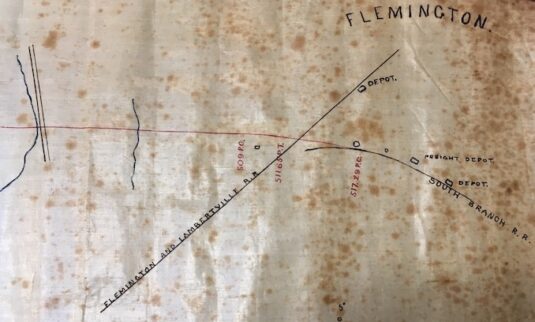
Above is a detail of Slaymaker’s survey map showing the end of the line for the Delaware Flemington Railroad. Below is a detail from Beers Atlas showing how well-developed the Flemington depots were in 1873.
As you can see from the detail of the Beers Atlas toward the beginning of the story, the station at Flemington had shops for maintenance work, two depots and two turntables, one close to the Main Street depot, and the other next to William Hill’s property. The depot for the Flemington Railroad & Transportation Co. was the one located near Mine Street, and the other one, on Main Street, was for the South Branch Railroad Co.
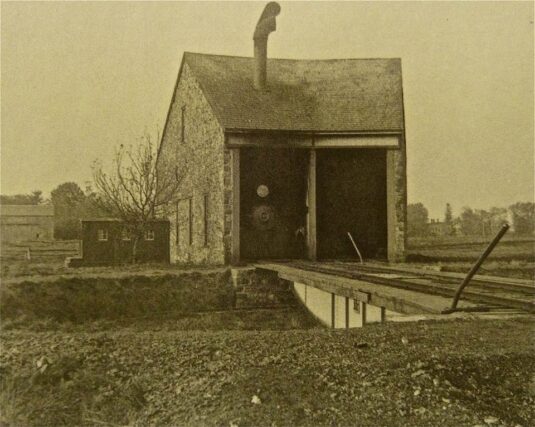
This remarkable photograph was taken in 1900 by Asa Stryker.12 It shows an ‘armstrong turntable’ in front of the Pennsylvania Railroad ‘roundhouse’ in Flemington. Railroad historian Shane Blische explained that “four men, or two really strong men, would push on those railings on the turntable at opposing ends to turn the locomotive around. The roundhouse and turntable were located roughly where the Lone Eagle Brewery in Liberty Village is located now.” The so-called ‘roundhouse’ was actually a service station for locomotives, called ‘round’ because of the turntable.
And here once again, we have a subject that deserves much more attention than I can give it here: the railroads for which Flemington was a destination. The first one to arrive was the Flemington Railroad and Transportation Company, which completed its construction connecting Lambertville and Flemington in 1854. On December 13, 1854, the Gazette announced that the train would be running on the 20th of that month, leaving Flemington at 7:00 a.m. It would travel to either Philadelphia or New York.
But there was no train, as yet, connecting Flemington directly to New York. That would not happen until 1864 when the South Branch Railroad Company completed its line from Somerville to Flemington. That was a big day for the Village. In the meantime, Flemington travelers would have to go to Lambertville, either by train or by stage, where they could catch the Belvidere Delaware Railroad line to Trenton, and from Trenton to pick up the Pennsylvania Railroad to Newark and Jersey City and then take a ferry to New York.
Shortly after the Flemington Railroad opened for business in December 1854, the Belvidere-Delaware Railroad Co., often called the Bel-Del, negotiated a lease to use the line as a spur to its own line running from Trenton to Phillipsburg. (Although the Bel-Del had been chartered as early as 1836, it did not begin construction until 1850.)
The two companies thereafter not only shared a rail line, but also had their annual meetings at the same time in the same place. Shane Blische noted that “On certain documents concerning operations of the Flemington Railroad through the 1860s prior to the 1871 lease by Pennsylvania Railroad, the name ‘Belvidere, Delaware & Flemington Railroad or Railroads’ was used during the Bel-Del lease.”
In addition, the two companies shared some of the same directors, including the transportation expert, Ashbel Welch of Lambertville, the man responsible for the D&R Canal and its feeder canal along the Delaware River. Other shared directors were Robert F. Stockton, Richard Stockton, Charles Bartles, Edwin A. Stevens, and Benjamin Fish. Additional directors for the Flemington Railroad & Transportation Co. board, who served for many years, were Flemington notables like Alexander Wurts, William P. Emery, John G. Reading and Hugh Capner. As noted above, John C. Hopewell came on board (so to speak) in 1870.
The Central Railroad Co. of NJ was chartered in 1831 to run from the port of Elizabeth west to Somerville. It finally got there in 1842. In 1847 it got a charter to run further west to Easton, PA. In 1864 it completed its “South Branch line”, connecting the main line at Somerville west to arrive at Main Street in Flemington, which created much excitement in the town. The South Branch Railroad Co. was always a subsidiary of the Central Railroad Co.
Things got even better for Flemington in 1866, when the Central Railroad Co. and the Belvidere-Delaware Railroad Co. negotiated successfully an arrangement allowing passengers from Somerville and parts east to travel on the Bel-Del’s leased line from Flemington to Trenton and on to Philadelphia.13
It is easy to see why the proposed rail line for the Delaware Flemington Railroad Company was aimed for Flemington, the connection point for the train to the eastern market cities. Presumably, cars from the Delaware Flemington R.R. trains would connect with the South Branch line just as the cars from the Flemington Railroad & Transportation Co. line did.
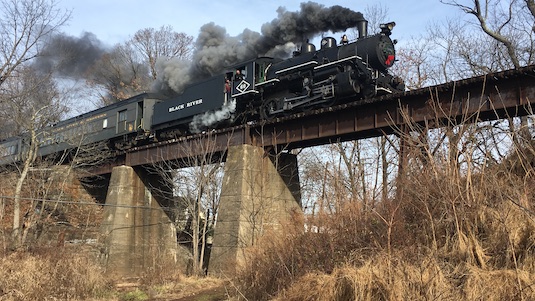
The photograph above was provided by Shane Blische. The #60 is a “Consolidation 2-8-0 steam locomotive,” built in New York in 1937 to haul freight for the Great Western Railroad of Colorado. It was sold to the Black River & Western Railroad Company in 1963, and from 2000 to 2012 underwent “a massive rebuild.” It is again in service, pulling trains on the BR&W line from Flemington to West Amwell. (Many thanks to Shane Blische, who graciously provided this information and reviewed & corrected my description of the railroad companies.)
Effect of Railroads on Real Estate
Generally speaking, people had a very favorable view of the railroads in the mid-19th century. They were something new, after all. No one today would be very keen about a rail line passing through their property. But real estate ads in the 1860s mention proximity to the railroads as a positive feature, including properties along the Flemington R.R. & Transportation Co.’s line in the Copper Hill neighborhood. Two examples from the Hunterdon Republican:
1868 Oct 1, Sale of Real Estate. On 12 Nov. 1868, Jonathan Muirhead will sell on the premises, the Valuable Farm now in his occupancy, containing 195 Acres, situate in Raritan Township, about 4 miles south of Flemington, . . . The Flemington and Lambertville Railroad passes through the farm, about 200 yards from the house.
1869 Jan 7, Property for Sale, on 7 Jan. 1869. Judiah H. Kuhl, about to relinquish the mercantile business, will sell his Store Property, at Copper Hill. This property consists of a large and convenient Store House, double dwelling house and tenant house, all nearly new. . . . The business facilities are unsurpassed, a depot of the Flemington Railroad being on the place, also the Post Office and Express Office are kept in the store.
In the case of George W. Scott’s farm in Readington, it was seen as a real advantage, as reported by his executor in the Gazette for Nov. 8, 1854:
EXECUTOR’S SALE OF REAL ESTATE. THE subscriber, Executor of the last Will and Testament of GEORGE W. SCOTT, dec’d., will sell at PUBLIC VENDUE, on FRIDAY, the 1st day of December next on the premises, a valuable FARM of about 150 ACRES of land in the township of Readington, county of Hunterdon, on the New Jersey turnpike road, 8 miles from Somerville, and one mile from the White House Depot of the Central Railroad, which furnishes a ready market at the highest prices for all kinds of produce, . . . As the Central Rail road passes through this Farm, dividing it into two nearly equal parts, it could very conveniently be laid off into two Farms of nearly equal size, . . . [signed] Isaiah P. Large, exr.
Ads like these continued through 1871 in the Hunterdon Republican.
Why Another Train?
Let us review why this rail line was wanted in the first place. The answer is easy—in one word: Peaches!
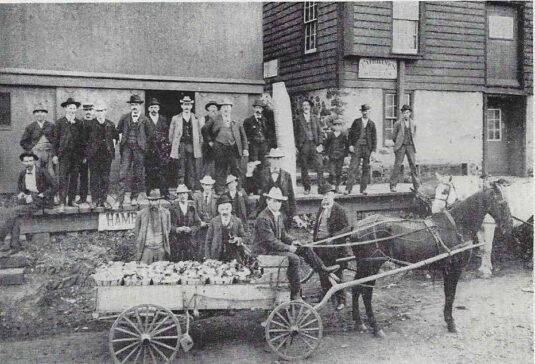 One of the best books on Hunterdon County history was written by Hubert G. Schmidt in 1946, titled Rural Hunterdon, An Agricultural History. Given that agriculture was the primary occupation for Hunterdon residents well into the 20th century, one cannot ignore the subject. Mr. Schmidt wrote (p.131): “One of the most interesting developments in the county’s economic history was the half-century-long commercial production of peaches.”
One of the best books on Hunterdon County history was written by Hubert G. Schmidt in 1946, titled Rural Hunterdon, An Agricultural History. Given that agriculture was the primary occupation for Hunterdon residents well into the 20th century, one cannot ignore the subject. Mr. Schmidt wrote (p.131): “One of the most interesting developments in the county’s economic history was the half-century-long commercial production of peaches.”
It may be hard to imagine, but after the Civil War, Hunterdon County was the Georgia of the north. Oh, to have been able to drive the old roads in April when the peach trees were in blossom. It must have been quite a sight!
Peaches had long been grown in Hunterdon County, along with the other typical fruits: apples, pears, grapes, cherries, etc. But it took a transportation revolution to make it possible for farmers to develop commercial markets for this very perishable fruit.
It began in the area around Trenton, thanks to the development of the Delaware & Raritan Canal in the 1830s. When the railroads came into use in the 1850s, farmers began expanding their peach orchards. Because of their delicacy, peaches were considered a luxury item, which meant there was a ready market for them in the metropolitan areas (New York, Trenton, Philadelphia). Farmers quickly caught on. A good example of the northward movement of the peach industry was this ad in the Hunterdon Gazette for Dec. 27, 1854:
THIRTY THOUSAND PEACH TREES. THE Subscribers have FOR SALE 30,000 PEACH TREES, of the best and choicest kinds, ready for transplanting. They will sell to Farmers or Peach speculators or any who wish to try this successful enterprise, at reduced prices, for cash. JAMES S. REED, DANL. D. REED, Titusville.
Dr. George H. Larison
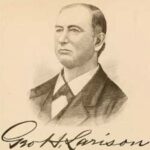
By 1860, the Gazette was taking notice. It reported on Feb. 1, 1860 that “Dr. [George H.] Larason, has recently received over 100 bushels of Peach stones, from Virginia, for nursery growing, and is looking for another cargo,” information the Gazette got from the Lambertville Beacon. On March 7, 1860, the editor noted: “The prevalent opinion in former years that fruit growing was an unprofitable business, has changed, and now we find places which annually abound in a luxuriant growth of fruit, that, a few years ago were barren and nearly worthless.” And on June 11, 1862, the editor observed that “The district growing them [peach trees] is principally Delaware, East and West Amwell.” But it soon included Raritan and Kingwood Townships and gradually made its way into the northern section of the county.
In addition to peach farmers, there were also tree farmers, that is, farmers growing peach trees for the peach farmers. The nurseries were also big business in Hunterdon County. That is how Dr. Larison got started. On October 10, 1860, Justis L. Nixon of Quakertown was advertising in the Gazette that he had 250,000 trees available, ready to plant. And interestingly, our William Hill was also selling peach trees in 1865, by his agent C. K. Johnson (as advertised in the Gazette of Feb. 22, 1865). Mr. Schmidt observed that by the early 1860s, despite the Civil War,
. . . Flemington, Ringoes, and Lambertville were sending consignments of peaches regularly to the New York market by rail. A new factor in farm values was the ability of the land to produce peaches.
Anyone advertising a farm for sale would always take note of its suitability for peach growing. Here’s just one example, from the Gazette (Nov. 21, 1860):
Land for Sale!! 155 acres on the road leading from Locktown to the Old Boar’s Head Tavern, adjoining lands of Asa Bosenbury, Elisha Warford, Joseph Robbins, and others. The improvements consist of a Frame Dwelling house, Milk house, a good Barn and Hovel, and a lasting well of water near the door. There are also on the premises Fruit Trees of various kinds, among which are ONE THOUSAND PEACH TREES, IN A THRIFTY CONDITION. Joseph Hibbs, Croton, P.O., NJ.
It is clear from the newspapers that peach orchards were even more of a real estate advantage than proximity to a railroad depot.
The Peach Growers’ Association
It didn’t take long for peach growers to realize they were in a position to negotiate with the railroad companies. In June 1862, a meeting was held in Ringoes, where local growers discussed how they could reduce the travel time so that peaches would get to market in better condition.14 Dr. Larison, who probably instigated the meeting, was “appointed to investigate matters with the railroad companies in regard to direct transportation.” At a follow-up meeting in July for “the peach growers of Hopewell, East and West Amwell, Delaware, Raritan and Kingwood,” which Dr. Larison chaired, the group organized into districts for the purpose of taking a survey of peach production, which was useful information to have when negotiating with railroad companies. A committee was named for that purpose consisting of Jacob S. Manners, East Amwell; John L. Borough [sic], Hopewell; Asher W. Vandolah, Kingwood; John P. Rittenhouse, Raritan, and J. L. Pullen, Hopewell. The Committee was instructed to insist that Fruit must be carried by way of New Brunswick.
Peach Trains
The railroad companies soon got the message. By 1863 they were advertising special “Peach Trains.” On Sept. 2nd of that year, the Belvidere Delaware Railroad Company announced that it had “commenced running a Peach Train regularly, for the accommodation of growers,” leaving Flemington at 4:10 P. M.; Copper Hill, 4:25; Ringoes, 4:40; Barber’s 4:55; Centre Bridge [Stockton], 5:05; Lambertville, 5:30; Moore’s 5:56; and Titusville, 6:06, arriving in New York at about 3 o’clock, A. M.
In August 1865, the South Branch Railroad Company advertised its own Peach Train, which “will leave the depot at Flemington immediately after the arrival of the evening passenger train from New York, stopping at all stations along the line of the road.”
As you can see from this photo of the Pittstown Station of the Central Railroad below, Flemington was not the only place where trains were greeted by peach farmers.
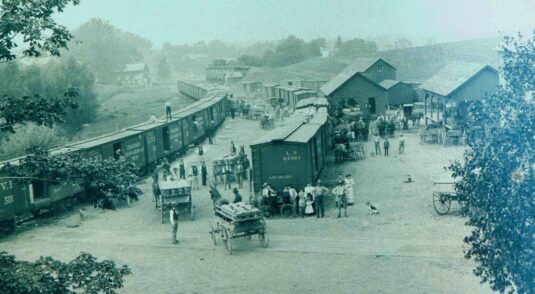
Dr. Cramer’s Survey
Many peach growers and peach nurserymen felt a new rail line was needed because the existing line was not up to the task of transporting in a timely fashion the thousands of peach baskets that were ready for market in the summer months. John W. Kuhl wrote that the Hunterdon County Democrat of Dec. 27, 1871, quoting from the New York Tribune, called the old Bel-Del branch to Lambertville “poorly operated and ineffective.15
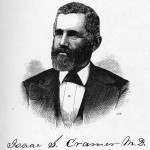
One of the company’s strongest supporters was Dr. Isaac S. Cramer. In addition to practicing medicine, he happened to be a very successful nurseryman on his farm near Sergeantsville. It was not a large farm. Cramer and wife Margaret sold the 9-acre property in 1905 to Lewis Higgins; the deed stated that it was the same lot sold to Cramer by Lemuel Higgins and wife in 1871. The deed included a stipulation that “the fruit, shade and ornamental trees on the sd lot are hereby reserved by the sd Cramer with privilege of entering sd premises with his workmen to remove the same. The fruit trees to be removed by June 1st, and shade & ornamental trees by Oct. 1st; the use of the fumigating house on sd premises is also reserved until June 1st. H.C. Deeds Book 147 p. 559 and Book 291 p.63. (Curiously, the train was not routed through his farm.)

Following the example of the peach growers, Dr. Cramer set out to do his own survey of farmers likely to use the proposed railroad.16 He managed to interview 244 farmers, only 12 of whom owned land along the proposed route. It was quite an accomplishment, considering his only access to them was by horse & carriage along pretty awful roads. Cramer’s survey is a fascinating one and will be dealt with to a greater extent in the future. Some, but far from all, of the farmers were using railroads to transport their crops, fairly evenly divided between “Penna” which was the Pennsylvania Railroad Company, i.e., the Flemington Railroad line from Lambertville to Flemington, and “P&R.” Shane Blische informs me P&R stood for Philadelphia and Reading Railway which originated in 1833 to haul coal in Pennsylvania. I do not know how Hunterdon farmers would have connected with this rail line; it’s just another example of how complex the history of railroad companies in the 19th century is. There were also a few farmers who used the Lehigh Valley Railroad, which was well north of Flemington, and may not have even opened for business yet.
The Company’s Failure
Out of Cramer’s 244 respondents, only 126 said they would use the proposed line, leaving 118 who would not. His survey was not a great endorsement.
I have discussed to a certain extent in a previous article (“The Railroad That Wasn’t Built”) why the rail line never got built. In that article I included the scolding of Delaware Township farmers by the editor of the Hunterdon County Democrat for being “so backward.” That lack of interest certainly showed up in Cramer’s survey. There was also a lack of interest among financial investors.
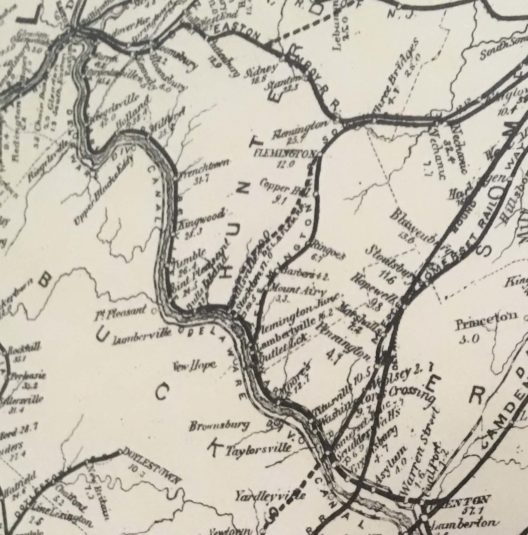
And naturally, there was a lack of enthusiasm among the competing railroad companies. After all, this line was very close to the existing Pennsylvania Railroad line, as you can see in this detail of a map of New Jersey’s rail lines in 1876. The proposed line is shown as a dotted line, even though it was a dead letter by that time.
John W. Kuhl wrote that the influential Camden & Amboy Railroad Co. and the Bel Del Railroad Co. choked off state support for this new upstart. That together with the Panic of 1873 made raising money from investors far too difficult, so the plan was dropped, and the train never did make it to the station.
Footnotes:
- H.C. Deed Book 115 p.277, Book 139 p.51. ↩
- H.C. Deeds 106-709, 112-759. ↩
- H.C. Deeds Book 123 p.152. ↩
- H.C. Deed Book 135 p.174; and going further back, 36.61 acres sold to Shrope by the Central Mining Company in Deed Book 104 p.617. For more on the Shropes, see my previous article, “Sergeant & Hastings“. ↩
- As far as I know, these children never did marry. Three other children did: Adelia, who married George A. Capner; John B. who married Annie Crater; and Mary or Mellie who married Thomas S. Chittenden. ↩
- H.C. Deeds Book 23 p.114, Book 30 p.456. ↩
- H.C. Wills Book 10 p.100. ↩
- Information found in the Hunterdon Gazette for 31 July 1844, 2 July 1845 and 7 July 1847. ↩
- Hunterdon Gazette, March 4, 1857. ↩
- H.C. Deed Book 151 p.30. ↩
- H.C. Deed Book 153 p.321. ↩
- From the R. K. Stryker Collection. Shared by Shane Blische. ↩
- Hunterdon Republican, Jan. 24, 1866. ↩
- This and following information taken from the Hunterdon Gazette. ↩
- From the draft for a future article to be published in the Hunterdon Historical Newsletter. ↩
- The complete survey, as written out by Dr. Cramer, can be found at the Hunterdon Co. Historical Society in the collection of papers for the Delaware-Flemington Railroad Co. ↩
MarleneT
January 9, 2021 @ 8:35 am
Great article! Love the history of the properties and individuals involved where the rail road was being built.
Interesting information of peaches in Hunterdon County! You have great photos of the old round house and the locomotive! Nice touch! Always enjoy reading your stories!
Samuel P Waugh
January 11, 2021 @ 7:18 pm
Marfy, the peach business seemed to have moved across the river to Solebury, Bucks County, Pa. My brother, friends Doug and James McMichael , and I used to walk across the bridge at Bull’s Island (the McMichael’s lived on the island before it became a State Park) to Lumberville and then down to Cutaloosa Creek and up the hill to what was then called Pine Cone Orchard. The orchard is still in operation as Manoff Market Gardens – but it remains a peach orchard royale. Their rivals back in the day (1970) was an orchard in Center Bridge, now called Burgess Lea, right on the River Road as you head north just past Dilley’s Corner. Both orchards also included apples for fall harvest, but peaches were the featured fruit for both. I don’t know of any peach or apple orchards still operating in the ’60’s in Delaware township though many people had individual trees – plus pears, cherries, etc. It seems chickens and peaches dominated Delaware’s past.